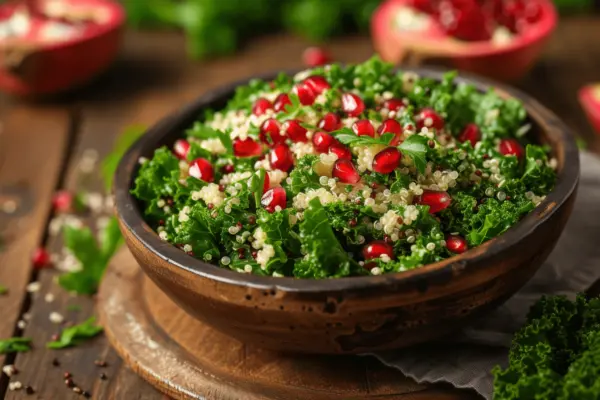Embark on a journey into the world of Kale Elegance, where the deep green leaves of kale not only captivate with their beauty but also deliver a symphony of health benefits.
Kale Elegance
Health Benefits:
Rich in Nutrients: Packed with vitamins A, C, and K, kale is a nutrient-dense leafy green that promotes overall health and boosts your immune system.
Antioxidant Superstar: Kale is a potent source of antioxidants, helping to combat oxidative stress and reduce inflammation, contributing to a healthier you.
Heart Health Support: The high fiber and potassium content in kale can contribute to a healthy heart by regulating blood pressure and cholesterol levels.
Detoxification Ally: Kale contains sulfur compounds that aid in liver detoxification, supporting the body’s natural cleansing processes.
Athletic Performance:
Muscle Support: Kale is rich in iron, crucial for oxygen transportation in the body, promoting endurance and reducing fatigue during physical activities.
Joint Health: The anti-inflammatory properties of kale can contribute to joint health, supporting flexibility and reducing the risk of injuries.
Energy Boost: The combination of iron and B-vitamins in kale enhances energy metabolism, providing a natural and sustained energy boost for your workouts.
Ways to Enjoy Kale:
1. Kale and Berry Smoothie:
– Blend kale leaves with mixed berries, banana, and yogurt for a vibrant and nutrient-packed smoothie.
2. Massaged Kale Salad with Avocado:
– Massage kale leaves with olive oil, add avocado, cherry tomatoes, and a light dressing for a hearty and delicious salad.
3. Kale Chips:
– Bake kale leaves with olive oil and your favourite seasonings for a crunchy and nutritious alternative to traditional chips.
4. Kale and Quinoa Bowl:
– Create a nourishing bowl with cooked quinoa, sautéed kale, chickpeas, and a tahini dressing for a protein-packed meal.
5. Kale Pesto Pasta:
– Blend kale into a vibrant pesto sauce to toss with your favourite pasta for a flavourful and wholesome dish.

Nutritional Information
Per 100g of Raw Kale:
| Nutrient | Amount |
|---|---|
| Calories | 50 |
| Protein | 3.3g |
| Fiber | 2g |
| Vitamin A | 206% DV |
| Vitamin C | 134% DV |
| Vitamin K | 684% DV |
| Iron | 6% DV |
| Potassium | 10% DV |
DV: Daily Value based on a 2000-calorie diet.
FAQs
Q: Can I eat kale raw?
A: Absolutely! Raw kale is a nutritious addition to salads and smoothies.
Q: How often should I consume kale for maximum health benefits?
A: Aim for 2-3 servings per week to enjoy the full spectrum of kale’s nutritional benefits.
Q: Is kale suitable for a gluten-free diet?
A: Yes, kale is naturally gluten-free, making it an excellent choice for those with gluten sensitivities.
Is it Better to Eat Kale Raw or Cooked?
Eating kale raw or cooked depends on your nutritional goals and taste preferences. Raw kale is rich in vitamins C and K and retains its antioxidant properties. However, cooking kale can make it easier to digest and increase the availability of some nutrients like beta-carotene. Lightly steaming or sautéing kale is a good compromise, preserving most nutrients while making the vegetable more palatable and easier to digest.
Should You Steam or Boil Kale?
Steaming kale is generally better than boiling. Steaming helps retain more of the vegetable’s nutrients compared to boiling, which can cause water-soluble vitamins to leach out. Steaming also maintains the texture and color of the kale better than boiling. To steam kale, place it in a steamer basket over boiling water for about 5 minutes until tender.
Why Do We Put Kale in Boiling Water for One Minute?
Blanching kale in boiling water for one minute helps reduce its bitterness and soften the leaves, making it more palatable. This process also helps preserve its bright green color and some nutrients. After blanching, quickly transfer the kale to an ice bath to stop the cooking process.
Can You Freeze Kale?
Yes, you can freeze kale. To freeze kale, first, blanch the leaves in boiling water for one minute, then transfer them to an ice bath. After draining and drying, spread the kale on a baking sheet to freeze individually before transferring to an airtight container or freezer bag. This method helps preserve the texture and nutritional value of the kale.
Is Out of Date Kale OK?
Kale that is past its expiration date is not recommended for consumption if it shows signs of spoilage such as yellowing, sliminess, or a bad odor. However, if the kale still looks fresh and does not have an off smell, it may still be safe to eat. Always use your best judgment and prioritize food safety.
Why Should You Not Microwave Raw Kale?
Microwaving raw kale can result in uneven cooking, which may lead to some parts being overcooked while others remain raw. This can affect the texture and taste negatively. Additionally, microwaving does not enhance the flavor or nutrient availability as effectively as steaming or sautéing. For best results, use methods like steaming or blanching to prepare kale.
Does Lemon Juice Soften Kale?
Yes, lemon juice can soften kale. The acidity in lemon juice breaks down the tough fibers in raw kale, making it more tender and easier to eat. To soften kale with lemon juice, massage the leaves with a little lemon juice and olive oil for a few minutes until the kale becomes tender and bright green. This method also adds a refreshing flavor to the kale.